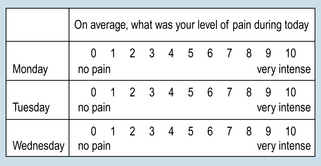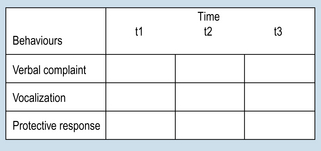13 When research involves the observation of people, self-observation becomes feasible and, at times, desirable. As an example, consider the study of pain. Here the patients themselves are uniquely positioned to provide subjective evidence concerning the intensity and location of pain over a period of time. Figure 13.1 shows a typical chart for guiding self-recorded pain observations in chronic pain patients, which is used in both research and clinical assessment. The self-observations of the patients provide data for understanding how patients’ pain experiences change over time, events correlating with the onset and offset of the pain and also evidence for evaluating the relative effectiveness of pain management strategies. Given that the experience of pain may be expressed in the sufferer’s overt behaviour, we may observe such pain-related behaviours when assessing pain. For instance, in a study involving comparison of pain behaviours of surgical patients with different cultural backgrounds, independent observers recorded pain-related behaviours in patients at agreed time intervals during physiotherapy treatments. Figure 13.2 is based on whether the observers recorded a yes or no for each category for each time interval in which the behaviours were sampled. There are probable relative advantages and disadvantages to using self-observation or outside observers, as shown in Table 13.1. Table 13.1 Advantages and disadvantages of using self-observation or outside observers The disadvantage with laboratory settings is that the phenomenon being observed may change when it is being observed in an artificial setting. This is particularly true for human behaviour, where the social contexts are important determinants of the behaviours and experiences. Indeed, the discipline of social psychology is devoted to the study of these effects. In other words, laboratory research sometimes has problematic ecological validity in that the findings discovered in this context may not generalize well to other ‘real world’ contexts such as in the clinic or the community. Table 13.2 summarizes some of the relative advantages and disadvantages of laboratory and natural settings for making observations. Table 13.2 Advantages and disadvantages of laboratory and natural settings for making observations There are, however, certain disadvantages associated with using instrumentation. These issues are discussed later in this book, when we review instrumentation and measurement. In other words, observation and measurement are closely interrelated (see Ch. 12). We can note here, however, that the use of instruments may distort the event being observed; for example, the preparation of tissue for electron microscopy changes to some extent the internal organelles of a cell being observed. These effects are very well known and documented. It requires considerable expertise to use more complex instruments, and a strong theoretical background to separate the artefacts from useful data and interpret the observations. Human research participants also react to being observed. The more intrusive the observer is with equipment and instruments, the more likely that the participants’ behaviour will change. The use and relative advantages and disadvantages of recording techniques were discussed in the context of interviewing techniques earlier in the book (see Ch. 12). Table 13.3 represents the relative advantages and disadvantages of using instruments for aiding observations. Table 13.3 The advantages and disadvantages of using instruments for aiding observations
Observation
Overview of different approaches to observation
Who is to make the observations?
Advantages
Disadvantages
Self-observation
Greater access to participative experience (introspection)
Less intrusive
Less expensive
Greater bias
Less likely to record accurately
Less likely to carry out observation as agreed
Outside observer
Greater objectivity
Less bias
More likely to record accurately
More likely to carry out observations as agreed
Cannot directly access participant’s perceptions
More intrusive
More expensive and time-consuming
Settings in which observation is conducted
Advantages
Disadvantages
Laboratory setting
Better control over extraneous variables
Observation aids and recording equipment available
Distortion of phenomena in artificial environments
Problematic ecological validity
Natural setting
Increased ecological validity
Observation of phenomena as they occur naturally
Little control over extraneous variables
Observation aids and recording equipment may be more difficult to use
Issues in the use of unaided observation or the use of instrumentation
Advantages
Disadvantages
Unaided observations
Less disruptive
Best suited for observing human behaviour
Relatively simple and inexpensive
Insufficient for observing some phenomena
Insufficient accuracy and detail
Instrumentation
Access to events outside unaided human senses
Increased accuracy and detail
May distort phenomena
May be complex and expensive to use![]()
Stay updated, free articles. Join our Telegram channel

Full access? Get Clinical Tree


Observation
Get Clinical Tree app for offline access


